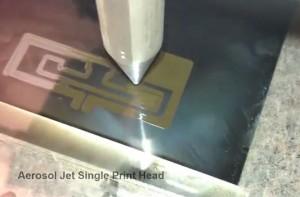 3D printing has unquestionably changed the way that all of the products that we use on a daily basis are designed and manufactured. From product development using rapid prototyping to small scale production and manufacturing, more industries than ever are using 3D printing to make better, and cheaper, consumer goods. One of the end goals of the 3D printing industry has always been the ability to print entire, market-ready products that incorporate ready to use electronics using multiple material 3D printers. While our current capabilities make that advancement still a ways off yet, several leading universities and high tech companies are paving the way.
3D printing has unquestionably changed the way that all of the products that we use on a daily basis are designed and manufactured. From product development using rapid prototyping to small scale production and manufacturing, more industries than ever are using 3D printing to make better, and cheaper, consumer goods. One of the end goals of the 3D printing industry has always been the ability to print entire, market-ready products that incorporate ready to use electronics using multiple material 3D printers. While our current capabilities make that advancement still a ways off yet, several leading universities and high tech companies are paving the way.
Thanks to a collaboration between the UK’s Centre for Process Innovation (CPI) and the University of Kent we have taken one step closer to 3D printed electronics. The duo 3D printed a bracelet that combines the latest 3D printing processes with advanced antenna and RFID technology. The University of Kent took charge of the design and 3D Printing of the wrist band, while the manufacturing of the antenna component was 3D printed at CPI’s National Centre for Printable Electronics.
The University of Kent is considered one of the leading centers of development of antenna and RFID technology while CPI is at the forefront of advanced electronics 3D printing technology. The goal of the collaboration was to create wearable products capable of being 3D printed quickly with little to no assembly that were capable of acting as tracking or identification devices. The design would allow for use-specific customization, from patient bracelets to be used in hospital settings that connect to local wi-fi hotspots and then to integrated equipment identification tags. With over 10 years of experience developing antenna and radio frequency technology the University of Kent’s Lecturer in Electronic Systems Dr Benito Sanz headed up the effort on the university’s side.
“The demonstration of a working prototype represents a significant achievement in the commercialisation of wearable electronics, in this case the integration between a 3D printed bracelet and printed antenna technology. Printable electronics provides a number of opportunities for wireless sensors such as the ability to manufacture antennas that are both conformable and extremely cost effective to produce at mass scale. Moving forward, further developments will focus on the optimisation of the process and the scale up of the technology from prototype scale to pilot production scale,” said Sanz.
CPI is a technology innovation centre that aids high tech startups to develop, prove, prototype and scale up the next generation of electronic products and manufacturing and fabrication processes. Their facilities combine science and engineering with state of the art research and development technologies to help their clients understand how their products and technology will perform when manufactured at high volumes, potentially accelerating their production schedule and reducing costs.
 The antenna was printed using an aerosol jet 3D printing technique using a type of silver ink that can be formed into geometries that cannot be reproduced with any other manufacturing method. These inks can be printed onto virtually any surface in an almost unlimited number of configurations. Not only will this lower the cost and increase the functionality of wearable electronics that traditionally manufactured, rigid circuit boards can’t provide, but they can be produced quickly for high volume manufacturing.
The antenna was printed using an aerosol jet 3D printing technique using a type of silver ink that can be formed into geometries that cannot be reproduced with any other manufacturing method. These inks can be printed onto virtually any surface in an almost unlimited number of configurations. Not only will this lower the cost and increase the functionality of wearable electronics that traditionally manufactured, rigid circuit boards can’t provide, but they can be produced quickly for high volume manufacturing.
The ability to mold electronic components like circuits or antennas will open up an entire host of new design and geometry options for personal electronic devices and wearable technology. It will also allow for the manufacturing of stronger, lighter, smaller and more comfortable wearables that will wirelessly connect to the internet. These devices will be smarter and more interactive while providing a user friendly interface and fit. For instance, perhaps a consumer electronic product like a fully functional smartwatch that won’t cost five to six hundred dollars, will run on less power and can be customized into user-specific shapes and styles.
Subscribe to Our Email Newsletter
Stay up-to-date on all the latest news from the 3D printing industry and receive information and offers from third party vendors.
You May Also Like
3D Printing News Briefs, April 13, 2024: Robotics, Orthotics, & Hypersonics
In 3D Printing News Briefs today, we’re focusing first on robotics, as Carnegie Mellon University’s new Robotics Innovation Center will house several community outreach programs, and Ugogo3D is now working...
Rail Giant Alstom Saves $15M with 3D Printing Automation Software 3D Spark
3D Spark has entered into a three-year deal with the rail giant Alstom. Alstom, a transport behemoth with annual revenues of $16 billion, specializes in the manufacture of trains, trams,...
Meltio Expands Global Reach with New Partnerships in the Americas and Europe
Spanish 3D printing manufacturer Meltio has expanded its sales network across the globe. With the addition of three new partners in the United States, Brazil, Argentina, and Italy, Meltio aims...
3D Printing Webinar and Event Roundup: April 7, 2024
Webinars and events in the 3D printing industry are picking back up this week! Sea-Air-Space is coming to Maryland, and SAE International is sponsoring a 3D Systems webinar about 3D...































